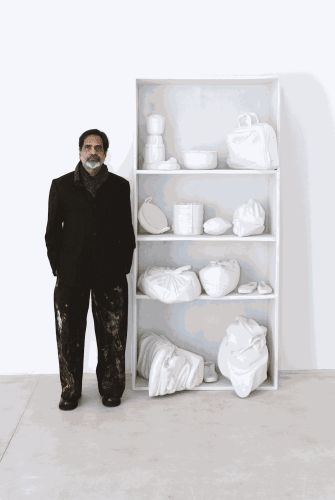His work has been exhibited at the Fukuoka Asian Art Museum, Fukuoka, Japan, and the Tate Modern, London, England.
The artist has been a resident at the Mattress Factory, Pittsburgh, United States, and was a Ford Foundation Fellow at the New School for General Studies, New York.
In 1999, he was the only Indian artist commissioned to make a public sculpture (Home and Away) in Fukuoka, Japan, as a part of Hakata Reverain Art Project, curated by Fumio Nanjo.
Sudarshan Shetty was born in a bunt family[ at Mangalore, India, in 1961. Though Shetty was born there his family moved to Mumbai when he was an infant of six months. Sudarshan Shetty's father, Adve Vasu Shetty was himself a kind of artist, specifically a performer in Yakshagana. There was "a lot of music and singing in the house" where he grew up. Sudarshan Shetty trained in painting at the Sir JJ school of Art, Mumbai, during the late 1980s, but found himself increasingly attracted to the idioms of sculpture and installation. From 1989 to 1991, he worked at the Kanoria Centre for the Arts in Ahmedabad. There he interacted closely with colleagues at the National Institute of Design and the Centre for Environmental Planning and Technology. Through these conversations, Shetty honed his knowledge of the relationship between sculpture, design and architecture. Shetty currently lives in Chembur, Mumbai.
Sudarshan Shetty's oeuvre has been defined mostly by large sculptural installations and multi-media works. Experimenting with innumerable materials and medium his installations or assemblages use quotidian objects juxtaposed in an attempt to open up new possibilities of meaning. Eschewing straightforward devices of narrative and explicit symbolism and displaying a fascination for the mechanics of toys and mechanised objects, Shetty infuses domestic, essentially inert objects with new life. The world of everyday contraptions, objects (especially those from middle class showcases, or shop-front show windows), continues to be reconfigured from moment to moment in his work)
He often uses simple, repetitive, mechanical movements and sound in kinetic works that explore aspects of temporality. Shetty says, “The ploy is to attract the viewer and then to disenchant them with the mechanical movement.” These mechanical pieces together with scenes of domestic interiority are conceived to create places of amusement or what Shetty refers to as a ‘fairground spectacle’. Things form a gaggle of actors, their movements become acts in a play.
“The idea is definitely to bring in the activity of a market place to the fore. This is also a ploy to bring in a passerby into this arena – to seduce with the familiar.”
Sudarshan's earlier concerns and themes evolved around the politics of absence or loss of body, of death, of ‘being elsewhere’. The artist's preoccupation with absence or what he calls the ‘philosophical absence of a physical body’ was an inherent part of shows like Consanguinity (2003), Eight Corners of the World (2006) and Love (2006). ‘I am interested in the idea of absence, a human absence, of being elsewhere. I think most of us are condemned to be elsewhere: I embrace this predicament and rejoice in it.’
With his recent shows The more I die the lighter I get and this too shall pass and for a few years preceding it Sudarshan has become more absorbed with the ideas of futility and meaninglessness. Heightening notions of futility through repetitiveness, where mechanical shoes walk on and on, vessels fill and empty and coats dip in and out of liquids, there is artifice in the making of the work itself and in staging it where the object becomes the referential to the real event maybe distant in the viewer's memory of it. Transience and mortality are underlying themes in his recent works where ‘the compulsions of an engagement with the world and the resultant disenchantment are two sides of the same coin.’ For Shetty being part of the process and engage with it are no longer seen as choice because ‘only through an exercised distance with it I may have a chance to arrive at some answers.’
“In setting-up of most of my shows, the artifice involved in ‘staging’ a show becomes an inherent part of the exercise. I am interested in playing out the fictional aspect in creating a sense of ‘drama’ or a ‘spectacle’, and at the same time, revealing the meaninglessness involved in doing so. And both these positions remain mutually inclusive and feed off each other in the work.”
Several of Shetty’s kinetic works are characterised by the use of the skeleton. The skeletons represent the lost body and also evoke futility in their process of facture. The artist acquires an actual skeleton, takes it apart, makes a mould for each piece of bone, casts them all, and reassembles the skeleton in stainless steel. There is a certain futility in the painstaking procedure that is particularly the futility of art. Skeletons have featured in almost all of Shetty’s shows in the last decade from the mechanical dinosaur making metallic love to a sports car (Love 2006) to the stilted bull in "The more I die the lighter I get" (2010) and the rocking skeleton of a horse in "This too shall pass" (2010).
Mumbai, in all its visual abundance and diversity is Shetty's main source of information and inspiration. Most of what he calls “the information for my work” comes, he says, “from my day-to-day negotiation with this city.” The city provides the backdrop for his recordings of the unfolding, renting and unfurling of human life.
